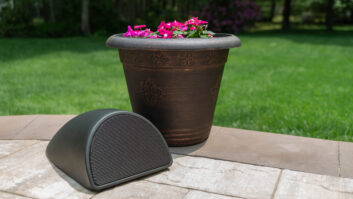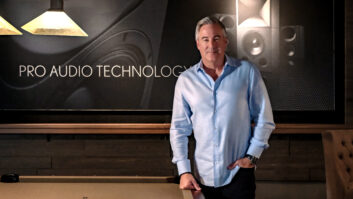When Brad Smith decided that the time was right for his company, Audio Video Design, to build a new design center where he could demonstrate electronics in a lifestyle setting, he first had to overcome a few obstacles.
Having run an installation business for 21 years, Smith believed that he must remain true to his “custom electronics contractor sensibility” by maintaining a “certain” look, location, resources, product mix and personnel style. Remaining in the Boston area (Newton, Massachusetts), however, would be Smith’s first big challenge.
“I started looking at new space with a long-term lease or a purchase in mind. It took hundreds of hours,” Smith explained. “I wanted to stay in metro Boston even though the real estate prices are very high ($25-50/foot for rent or $100-200/foot for purchase). There was practically nothing on the market for sale or lease. Our commercial broker identified a building in a primarily upscale residential suburb that would have to be a complete gut. It had been a butcher shop and meat distribution center.”
Yes you read that correctly; Smith’s best real estate option was a former butcher shop that already had seen its better days. The location of the facility, nonetheless, would prove attractive enough to overcome a “holy” roof and an ungodly smell.
“I was pretty turned off at the holes in the roof and signs of rodents, but most of all the animal smell that permeated the place,” Smith recalled. “It clearly had potential-the location was excellent, there was plenty of parking and we figured we could do anything on the inside.”
Not so fast; the city had strict building-use laws and Smith was going to have to jump through hoops to get his “use” approved. “We made our offer contingent on this approval, and then went through a long, time-consuming and expensive legal process. It was exasperating, but we finally prevailed.”
The next step involved hiring a demolition contractor, a commercial architect, an interior architect and a general contractor. Smith led the design team and his general manager dealt with day-to-day details. Because it wasn’t a complete demolition, Smith’s team ran into plenty of unpredictable problems, including issues with structural steel, wall joints, water tables and eliminating the all-pervasive odor of 50 years of meat processing.
“We rejected the option of acting as our own GC and it’s hard to say in hindsight whether he was worth the dough,” Smith said. “The demo and re-build took about six months (a very fast pace) but that didn’t include fitting out the showrooms, which took us another six months.”
The fruit of this labor is a space consisting of about 4,500 feet of showroom, 3,000 feet of warehouse and 5,000 feet of office space. “It has worked out beautifully. In fact, there’s very little that I’d change,” Smith said. “Each department has spare desk area for growth. The spacious warehouse is a delight. The small second-floor houses our accounting department and the alarm company I also own. The showrooms are things of beauty; it makes us all feel good to walk through them. Everyone is impressed. Do they get us business? Probably, but we haven’t had them running long enough to say.”
The building is a partnership with a member of Brad Smith’s family who wanted to make a real estate investment. The contents of the facility, according to Smith, are “mostly cash-flowed,” with a manageable bank loan for a cushion and a line of credit as a safety net. Smith had hoped that manufacturers would be more forthcoming in their financial participation than they were. Some of his vendors who did, however, help ease his burden include ADA, ADI, Aerial Acoustics, Bay Audio, Cinema Design Group, Crestron, Extron, JBL Synthesis, Litetouch, Klipsch, Madrigal, McIntosh, Niles, Pro Audio Associates, Stewart Filmscreen, Transparent Cable, Vantage, as well as some commercial A/V manufacturers.
A Tour of the Place: When a client enters the completed design center she faces a contemporary, custom-designed reception desk. Turn to the right and she enters the “Beacon Hill Study” in which a Runco 42-inch plasma and Bay Audio speakers are recessed for simplicity, and a handheld Crestron remote control hidden components.
Turn left at the reception desk and Smith’s client enters the light-cherry-accented “His Home Office” where a Crestron TPS-6000 display acts as a total home control and computer monitor, with one icon that brings up eight CCTV cameras in and around the building, a Zenith LCD TV among duck hunting prints on a faux-painted wall control that can be turned to face the desk’s occupant or his guest sitting on the other side of the desk, a pair of Triad monitors that blend into the bookshelves that are custom-stained to match the millwork and a stand-alone Linn Music Classik for when you want a local source. Walk out of the “Home Office” and into “Her Kitchen” done in a “warm wood” with grape leaf accents to hear Bay Audio JMr in-ceiling speakers, view recipes, check e-mail or peruse the wine cabinet’s contents on the Crestron touchpanel or unfold the 13-inch under-cabinet Sharp TV for the evening news while cooking on the Sub-Zero cook top. Cross over to the “Italian Garden” with Stereostone speakers and an ADA control pad and walk into the “Wellesley Living Room” where two surround sound systems, ADA Rhapsody components with Triad speakers and Anthem components with Canton speakers, a 60-inch Zenith plasma TV and a Runco CL-710 projector with a Stewart soffit-recessed screen are barely discernable, and a Crestron STX-1700C slides out from below the coffee table on a tray that also holds the kids’ video game gear.
Next, walk into the “Theater Lobby” and enter the AVD “Tea Room Theater” designed and built together with Cinema Design Group, where a Runco VX3C runs with either the JBL Synthesis II or the ADA Reference audio packages, controlled by a Crestron 6000 in a chair console and a 1700 sitting on the bar. As you leave the theater, look at the floor-to-ceiling Middle Atlantic rack, loaded with reference Transparent interconnects. Enter the “Executive Boardroom” with its fully-recessed Niles AT surround sound matched with Rotel and both a Fujitsu P50XHa10US plasma TV and a Sony VPL-VW12HT for residential applications and a Eiki LC-X986/Smart/Picture-Tel/JBL combination for commercial applications.
Finally, walk into the “Multi-Purpose Demonstration Room” to see and hear the recessed in-wall and in-ceiling speaker displays, the high-end two-channel display featuring Levinson, McIntosh, Aerial and Revel, the three Stewart screens to display the Marantz, Yamaha and JVC video projectors demonstrating three different technologies and the portable walls featuring structured wiring and networking, residential telecom and Litetouch lighting control. Covering half the wall and ceiling area are two-inch-deep Kinetics acoustical panels. In addition to AVD’s target customers the facility also will cater to design and construction professionals and will serve as a meeting place for local non-profit groups. “We are members of all the professional construction associations and will host meetings and socials,” Smith said.
Smith said that he hopes the new design center will enable AVD to grow and gain more economy of scale. “We need it to pay for the building,” he said. “It is costing a lot of money to do this. The initial investment, of course, was huge, but so is the ongoing expense. We keep the space spotless and we don’t tamper with the systems. Although we received some discounts, there’s a lot of demo product, just as much as a some retailers have and much of it is more expensive.”
For now, Smith and his staff will revel in the sheer pleasure that theirs is one of the best electronics contractor spaces in the country. “Obviously, not many CEDIA-type companies could undertake a project of this size,” Smith said.
Jeremy Glowacki is editor of Residential Systems.







